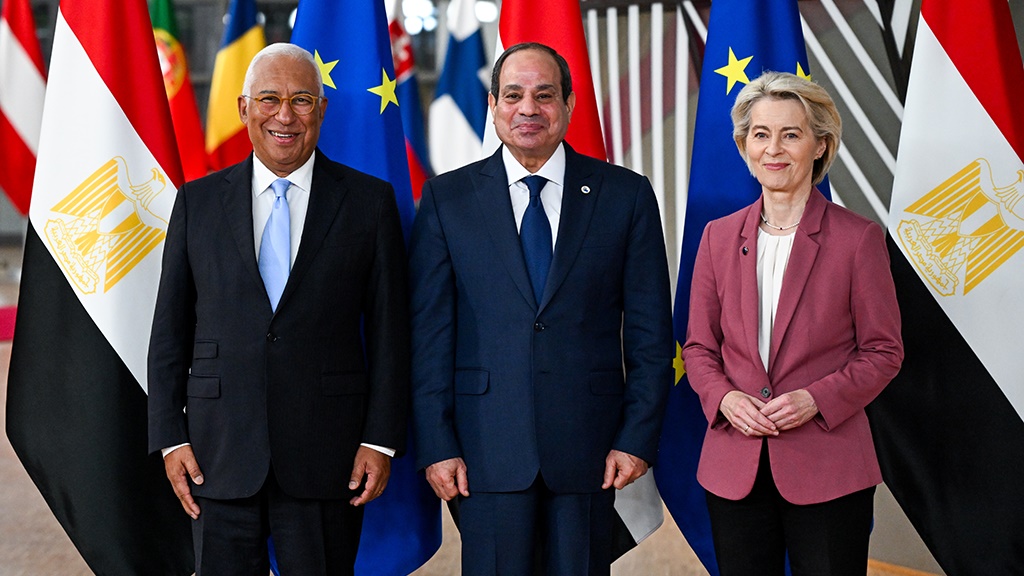Brussels deal deepens Egypt sovereign financing credibility
EGP=X steadies as Egypt secures €7.4 billion EU support through 2027; CDS near 350 bps and NG=F exports strengthen FX inflows, signalling tighter spreads and improving debt sustainability under EU-IMF reform benchmarks.

President Abdel-Fattah El-Sisi’s presence in Brussels for the Egypt–EU summit signals a strategic recalibration in Cairo’s external financing and reform trajectory. The discussion centers on a €7.4 billion support package for 2024-27, of which approximately €5.0 billion takes the form of macro-financial assistance, €1.8 billion investment guarantees and €0.6 billion grants. This conveys Egypt’s transition from short-dated, high-cost liquidity injections to longer-tenor, partially concessional European financing tied to reform milestones and structural investment channels.
Egypt’s economic backdrop remains constrained yet showing incremental improvement. Nominal GDP is estimated at approximately USD 349 billion in 2025, while the IMF projects real growth of around 4.3 % for calendar year 2025, up from 2.4 % in 2024. Annual urban consumer inflation reached 11.7 % in September 2025, down from a peak of nearly 38 % in September 2023. Egypt’s external debt stands at roughly USD 156.7 billion at end-Q1 2025, representing about 40.8 % of GDP and underscoring the urgency of improving the debt-servicing profile. These figures position Egypt among reform-track emerging markets but with sizeable residual risks.
The EU financing corridor enhances three transmission channels relevant for capital-market and fiscal dynamics. First, it anchors rollover risk by extending maturities and reducing reliance on high-coupon sovereign bonds maturing in 2026-27. Egypt’s five-year USD sovereign CDS recently tightened to the mid-300s basis points, having peaked near 800bps earlier in the year. Second, the investment-guarantee component is designed to crowd-in private capital into tradables and export infrastructures, reducing the crowd-ing-out effect of domestic state borrowing. Third, energy-security alignment with Europe deepens Egypt’s LNG and processing role in the Eastern Mediterranean, increasing hard-currency earnings linked to benchmark NG=F exposures and reducing fx-shock vulnerability.
Market pricing is responding to the improved external-funding signal. Local-currency Treasury yields for 3- and 5-year tenors have compressed by 100-150bps since August 2025 as foreign-holder appetite improved. The USD/EGP (ticker: EGP=X) crossed into a narrower trading band post-March 2024 float, indicating enhanced currency flexibility and dampened speculative premia. Meanwhile the EUR/USD (ticker: EURUSD) will remain an important input for imported inflation and commodity costs, reinforcing how global variables feed into Egypt’s balance-sheet adjustments.
Nevertheless, the headline numbers mask execution risk and structural inertia. Egypt’s current-account deficit remains elevated at around 5 %–6 % of GDP, driven by higher gas imports and compressed Suez-Canal receipts following shipping-route disruptions. The budget for FY2025/26 targets a primary surplus of 4.0 % of GDP yet is vulnerable if subsidy and wage bill reforms stall. Historical regional comparators such as Turkey or Argentina show that reform-embedded packages only unlock sustained sovereign spread compression when external inflows exceed USD 12-15 billion per annum and inflation falls below 10 % for multiple quarters.
For global institutional investors the summit implies a shift from ad-hoc crisis funding to investable reform-anchored instruments. The key forward indicators: five-year CDS below 350bps by Q2 2026; foreign direct investment excluding one-offs exceeding USD 12 billion in calendar year 2025; inflation sub-15 % y/y by end-2026; and auction-weighted local-currency yields for 3- to 10-year maturities falling by at least 150bps from Oct 2025 levels. Should Egypt meet those thresholds, the market narrative will shift from managing a balance-of-payments fragility story to recognising Egypt as a reform-investible emerging market with credible institutional back-stops.
Europe’s stake is equally significant. For the EU the Egyptian corridor fits the Global Gateway agenda and strengthens Europe’s energy and logistics nexus in North Africa. The partnership enhances Europe’s influence over regional stability and reduces reliance on Gulf-state capital and Chinese Belt-and-Road exposure. For Egypt, the strategic realignment imports institutional credibility, conditional finance and a pathway to convert large external flows into tradable-sector acceleration rather than recurrent restructuring.
Egypt thus stands at an inflection: if the Europe-driven financing, policy adjustment and structural investment combine to raise tradables output from the current ~23 % of GDP toward a target ~30 % by 2030, then the summit represents more than optics. It becomes the gateway to Egypt’s performant emerging-market reclassification and portfolio-capital inclusion





